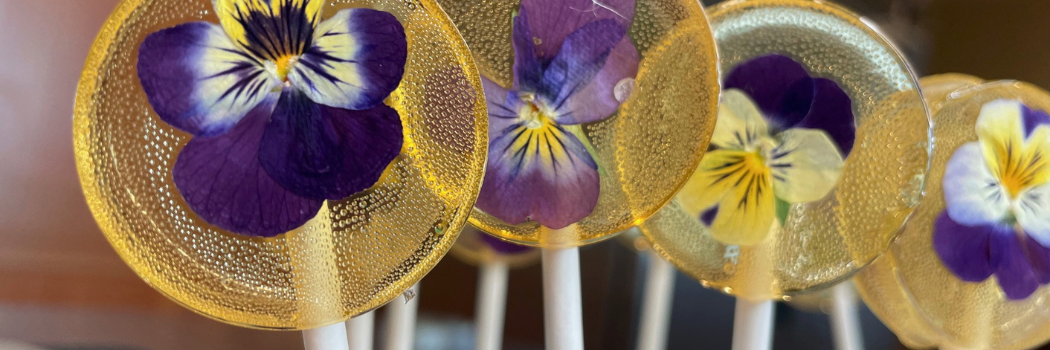- Johnny's Edible Flower Guide | Printable 4-pp Brochure (PDF)
- More Ideas for Edible Flowers (PDF)
- Edible Flower Recipes (PDF)
- Edible Flowers | Easy Choices for Salad Mix (PDF)
- Edible Flowers | Tech Sheet (PDF)
- Video: Growing Edible Flowers
- Video: Summer Squash Blossoms | Recommended Varieties for Edible Flower Production
- Edible Flowers List: Top 20 Favorites from the Slow Flowers Community
- Eat Your Flowers: Serve Up That Wow Factor With Edible Flowers
Edible Flowers List: Top 20 Favorites from the Slow Flowers Community
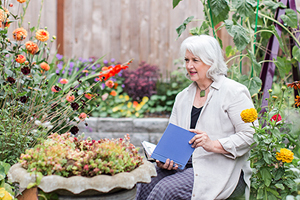
Debra Prinzing, Author & Founder of Slow Flowers
Photo: Missy Palacol Photography
By Debra Prinzing, Slow Flowers Society, January 2024
When chefs, bakers, and bartenders enhance their sweet and savory creations with edible flowers, they not only add visual excitement to their dishes, desserts, and drinks, but often their recipes deliver a surprise burst of flavor. Edible petals and flowers bring to the dining experience a new appreciation for all that nature has to offer.
And that’s why we’re hearing so much about edible flowers these days. The addition of a pressed violet to a cupcake or the sprinkling of calendula petals in a salad—these are small details that add big impact to your culinary efforts.
Top 20 Edible Flowers
We asked our Slow Flowers Community to list their favorite edible flowers and here are the Top 20 choices they shared. Some selections are familiar, but to be honest, some of these flowers surprised me and sent me off to do more research about the blooms’ edible qualities. What I learned is that there are many more edible flowers that I ever realized.
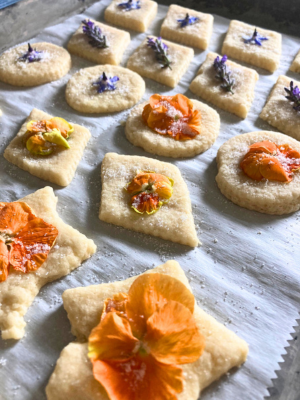
Image courtesy of SUOT Farm & Flowers
Pansy (Viola)
With a bicolored petal palette in shades of gold, purple, plum, lavender, rose, and white, the cheery pansy is one of the most recognizable flower forms. The flower head can be pressed to preserve its classic shape for cake decorating; or, when cut from the stem it can be used as a garnish. Its flavor is said to be grassy or earthy. Pastry chefs are fond of candied pansies, a method of preserving the flower with an egg white wash and a sprinkling of sugar crystals to dry overnight or bake in a low-temperature oven for a few hours before using.Nasturtium
The nasturtium is a prolific bloomer that self-sows with exuberance. The flower colors range from white to blood red, but the most commonly available nasturtium is bright yellow-orange. Use the flowers as garnishes, or stuff with soft cheese. The flowers can be minced and added to butters and the immature seed heads can be pickled. Nasturtiums are a popular choice for adding color to salad mix. The peppery-flavored foliage is also edible.Herbs
We know that herbs are edible, but the flowers produced by herb plants are distinctly interesting and infused with flavor for cooking and enhancing cocktails. Snip off the flower heads of basil, bee balm, borage, chives, all mints, oregano, and rosemary (among many others) to toss into salads and soups. Herb flowers are particularly pretty on cheese and charcuterie platters. The flower tastes are often quite similar to its corresponding herb foliage.Violet
The violet bloom is a popular edible flower. The petite form means you’ll probably want to use the whole bloom rather than attempt to press it. As with many herbs, removing the bloom will stimulate the plant to re-bloom, so pinch away!Marigold
With so many varieties of marigolds to choose from, you can’t have enough of this easy-to-grow annual. Individual flower heads can be used to decorate fresh salads and desserts. The petals pack a punch—some say it’s citrusy; others say the flavor is peppery—so you’ll want to experiment with the unique flavors offered by this family of blooms. Use the flowers to dress up salads and desserts or cook as an ingredient in egg or rice dishes. Remove the petals from the flower base before consuming as the base can be quite bitter.Calendula
Cherished for its joyful color, the calendula petals can be used fresh or dried in "flower confetti," soups, soufflés, rice dishes, baked goods, and to garnish desserts. Calendula is a popular choice for brightening up salad mix. The flavor is tangy and slightly bitter, so use in small quantities for big impact. Remove the petals from the flower base before consuming as the base can be quite bitter.Bachelors’ buttons
The cool blue-pink-purple tones of most bachelors’ button varieties make this flower a favorite edible accent for sweet and savory dishes. Its flavor is bland and mildly floral and its appearance lends romance to any menu.Dahlia
A popular garnish for wedding cakes, dahlia decorations add a three-dimensional character to any presentation. Individual petals are edible and can be plucked for sprinkling into recipes that call for a burst of color. The taste is reminiscent of lettuce—subtle and refreshing.Snapdragon
The flowers are a colorful garnish for salads, desserts, and drinks. Snaps’ flavor is floral and slightly bitter (some compare its taste to chicory), so remember that a little goes a long way!Lavender
Think of the classic menu for a formal afternoon tea, and lavender is sure to make an appearance, whether in scones and shortbread; pressed into soft cheeses; or infused into the pot of tea itself. Lavender flowers add such a pretty range of pale to dark purple into recipes. They are strongly floral in scent and taste, pairing well with citrus, berries, nuts, mint, and cinnamon.Rose
If you love rose petals in beverages, desserts, and savory dishes, you’ll want to use organic practices in your growing methods so you can safely use them in recipes. The flowers have a mild, floral flavor and are packed with nutrition: Roses contain antioxidants and are high in vitamins C, E, and A.Borage
A standout for its true-blue, starshaped flowers, the borage plant is also a gift that keeps on giving if you let it reseed from year to year. Add the flowers to salads or use to garnish cold drinks and desserts. Freeze as ice cubes. It has a mild cucumber flavor.Zinnia
The flavor of the zinnia in bud is milder than the more bitter mature flower, but the petals are entirely edible. Zinnias come in such a dazzling array of hues, so you can have fun creating multicolored petal mixes for salads and garnishes.Sunflower
Almost every part of the sunflower is edible, but the flower buds are particularly tasty when fried. The petals can be used as a garnish in salads and desserts; the flavor is bittersweet.Squash Blossom
Chefs have elevated squash blossoms to the status of a culinary delicacy. The flowers can be stuffed with soft, herbal cheeses; they can be dipped in batter and deep-fried for a crunchy delicacy. The flowers have a subtle flavor, reminiscent of young zucchinis, and can be eaten raw.Hyacinth Bean (flower)
Hyacinth bean graces the garden with glowing shades of purple, lilac, and rose all season long. In addition to being an excellent cut flower, the flowers are edible, imparting a sweet, mild, bean-like flavor that makes them a favorite in salads and as garnishes.Chamomile
This herb’s small, sweet-smelling, daisy-like flowers are beautiful when the entire flower head is used to decorate salads, drinks, cakes and other desserts. The chamomile flower flavor is slightly sweet and aromatic.Chrysanthemum
All Chrysanthemum flowers are edible, but like marigolds their flavor can change depending on the type. Their taste has been described as tangy, bitter, or pepper-like. The petals can be dried for inclusion in tea blends.Peony
Peony petals are edible and often appear in drinks, salads, and to flavor honeys, jellies, jams, and simple syrups. The flavor is subtle and floral.Lilac
A seasonal spring favorite, lilac florets can be treated similarly to pansies and violets—candied, used in syrups, and as a fresh garnish. The flavor of fresh lilac is somewhat astringent.
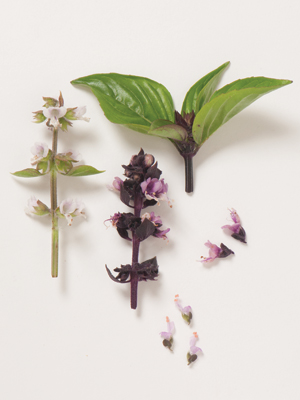
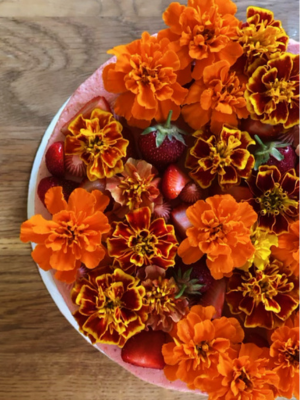
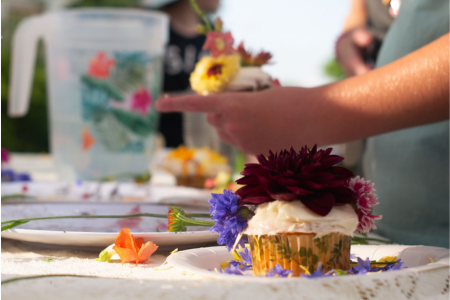
Image © John Palmer Gregg.
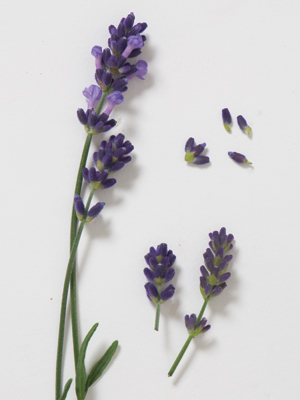
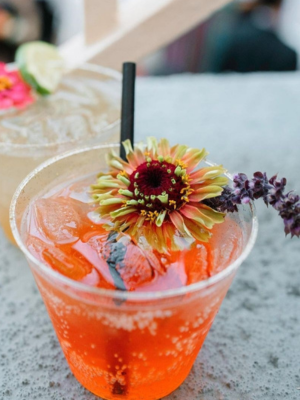
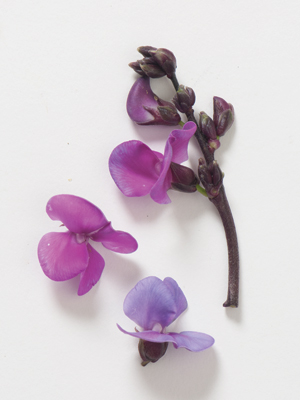
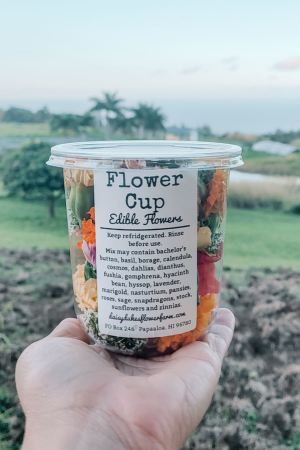
Image courtesy of Daisy Dukes Flower Farm
I hope this list will get you started exploring the wonderful world of edible flowers. Knowing that there are satisfying flavors that come straight from the cutting garden opens up an entire cookbook of options for exploration and experimentation. I can’t emphasize the importance of growing organically to ensure that your blooms are safe to eat!


